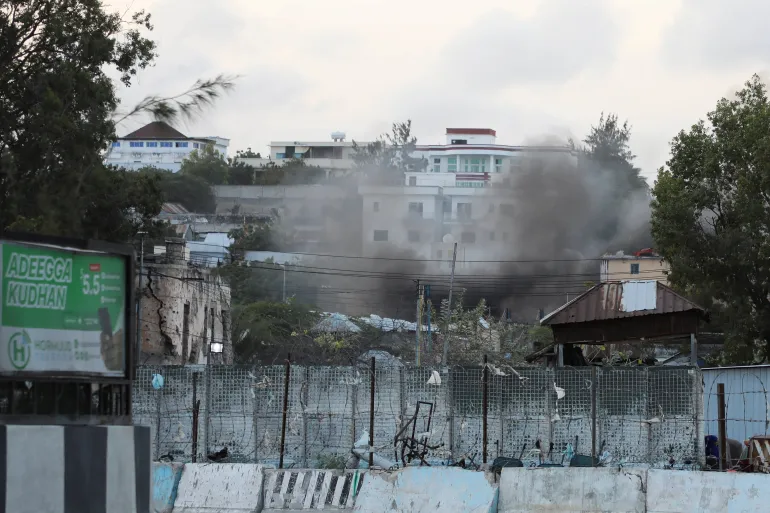At least seven people were killed on Saturday after Al-Shabaab militants launched a deadly attack on a high-security prison in Mogadishu, Somalia’s capital.
According to security officials, the assault took place at Galkacyo Prison, a facility located in the Bondhere district, just a short distance from the presidential palace.
The extremist group Al-Shabaab, which has been waging an insurgency against Somalia’s federal government for nearly two decades, claimed responsibility for the attack through its media outlet, Radio Andalus.
Details of Al-Shabaab Assault on A High-Security Prison in Mogadishu
Security sources confirmed that three armed militants remained at large inside the prison during the early stages of the assault.
The attackers reportedly stormed the facility using a vehicle disguised as belonging to the National Intelligence and Security Agency (NISA) in an attempt to deceive the guards and breach the fortified compound.
Senior security officer Abdulhamid Dahngad stated that four of the assailants were killed following an intense firefight with prison guards.
Tragically, one inmate and two security officers also died during the exchange of fire, while several others were injured.
Read also: How Somalis View Al-Shabaab Conflict — and What the World Often Misses
How Did Witnesses Say About the Attack on Galkacyo Prison?
Witnesses described hearing a massive explosion followed by heavy gunfire near the intelligence service headquarters, where captured Al-Shabaab fighters are typically interrogated.
Residents of nearby neighborhoods fled in panic as the situation unfolded, with plumes of smoke rising above the city skyline.
According to reports by the French Press Agency (AFP), the attack sent shockwaves across Mogadishu, once again highlighting the group’s ability to strike even the most secure locations like this high-security prison near the presidential palace.
Government Forces Repel the Attack
The Somali National Army (SNA), supported by intelligence and police units, responded quickly to the incident.
State-run media later confirmed that government forces had repelled the surprise assault and regained full control of the prison.
Authorities emphasized that the attack was part of Al-Shabaab’s ongoing efforts to undermine national security and destabilize key government institutions.
Resurgence of Al-Shabaab Attacks
In recent months, Al-Shabaab has intensified its activities across Somalia, capturing several towns and villages that were previously liberated by government forces.
This resurgence follows a period of setbacks for the group after a large-scale military offensive between 2022 and 2023, which had successfully pushed militants out of many southern regions.
Security analysts note that the group is now attempting to exploit political divisions within the country and logistical gaps in security operations.
Particularly as international support shifts under the African Union Transition Mission in Somalia (ATMIS).
Ongoing Security Operations
Somalia’s security agencies have vowed to continue counterterrorism operations in multiple regions to prevent further attacks.
The government reaffirmed its commitment to eliminating extremist threats and stabilizing the country with the support of international partners, including the United States and African Union forces.
Officials also confirmed that coordinated efforts are underway to strengthen intelligence sharing and tighten security around government facilities, prisons, and military bases in Mogadishu and surrounding areas.
A Longstanding Insurgency
Founded in 2004, Al-Shabaab is an Al-Qaeda-affiliated militant organization that seeks to impose its interpretation of Islamic law across Somalia.
Although the group was driven out of Mogadishu and other major cities between 2011 and 2012, it continues to control vast rural territories, where it imposes taxes and recruits fighters.
The latest attack highlights Somalia’s ongoing security challenges as the government faces the dual task of rebuilding institutions while combating a persistent and adaptive insurgency.
A Test for Somalia’s Stability
The assault on Galkacyo Prison serves as a stark reminder of the fragile security environment in Somalia.
While authorities continue to make progress in reclaiming territories and dismantling extremist networks, the threat of Al-Shabaab remains significant.
As Somalia moves toward political stabilization and security reform, the international community is closely monitoring the situation, emphasizing the need for sustained cooperation, intelligence sharing, and counter-extremism efforts to prevent the militant group from regaining its former strength.


